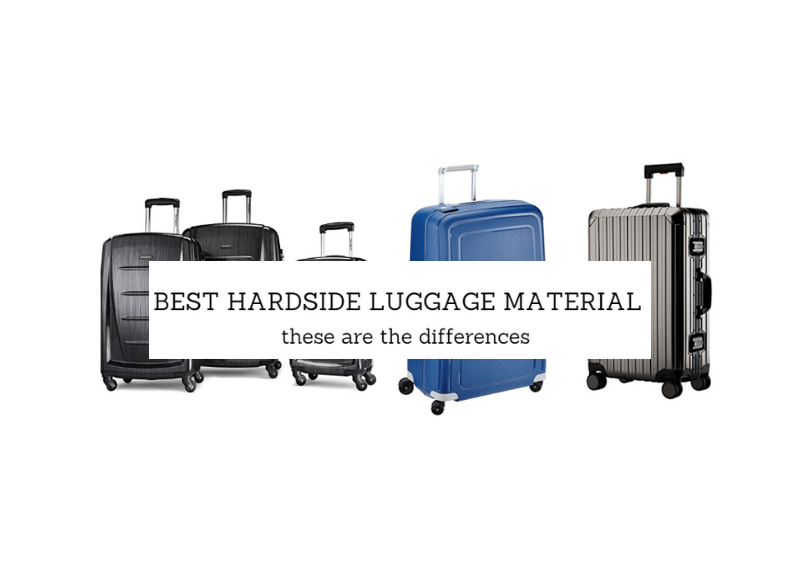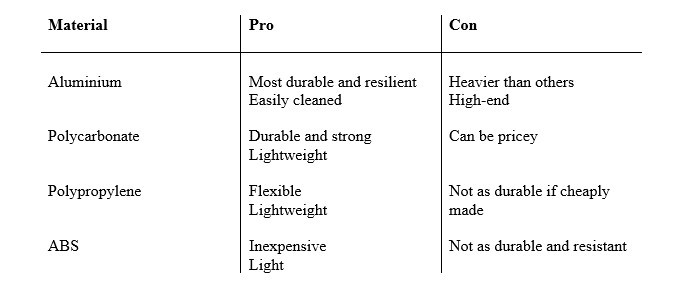
Best Hardside Luggage Material – These Are The Differences
You probably already know that hardsided luggage offers more protection for any fragile item you might pack. Which one is the best hardside luggage material though?
The materials used for hard case luggage differ widely and have been improved upon a lot since they were first invented and new innovations allow for expansion and even compression of certain hardsided luggage.
The following guide will tell you which luggage material is the most durable and how the materials differ.
The most used and popular materials for hard case luggage are aluminum (or aluminium), polycarbonate, polypropylene and acrylnitrile-butadiene-styrene (ABS).
[cmtoc_table_of_contents]
Aluminum (Or Aluminium)
Aluminum or aluminium luggage is known to be the most durable and resilient when it comes to hardside luggage materials. The material isn’t easily dented, but is strong and solid; it is also shock resistant, protecting your belongings on the inside of the case.
Aluminium luggage is easily cleaned and has a very distinct look about it, which is sure to stand out on the baggage carousel.
Luggage made of aluminum is usually heavier than other materials, but there are other options which use a combination of materials called aluminum magnesium alloy, which is also extremely durable and resilient, but also lighter than just aluminum.
Due to its high quality, aluminum luggage is a high-end product and comes with a higher price-tag. But you can be sure to have a long-lasting and very stylish looking suitcase.
Apart from being a bit heavier than other materials and coming with higher cost than some, aluminum is known to scratch easily, so when buying a case, make sure to get one with a design that won’t show marks easily (i.e. don’t necessarily go for the polished version).
Many times you will get aluminum in silver, black or sometimes a red colour. Different designs are stamped into the material, for example to make it look like woven texture.
Please note that many hardside cases have the same downside of showing scratches easily.
Rimowa is one of the manufacturers who uses either aluminium or polycarbonate for their luggage pieces. According to them, their aluminum-magnesium alloy luggage cases have naturally occurring corrosion resistant qualities and are fully recyclable.
This is something you will read quite often, that aluminum can be recycled again and again.
To sum up: aluminum luggage is the most durable, but might weigh more than other hardside luggage materials and might come with a higher price tag.
Polycarbonate
The word polycarbonate is a composite of polymer and carbonate. Polymers are synthetic organic materials such as plastic and resin. Polycarbonate being a composite of the two materials basically just means that it has properties of both those materials.
It is essentially a synthetic with the capacity to be easily changed into different moulded shapes. Because it’s transparent it is simple to give it diverse colours and patterns.
Apart from its diversity polycarbonate is also highly impact and temperature resistant and very lightweight. The other good thing about polycarbonate is that it can be put back into its original shape should it get dented.
Polycarbonate isn’t only used to make luggage, but is commonly used to make bulletproof glass, CDs, helmets and visors as well as safety glasses and goggles. NASA were one of the first to make helmets and visors from polycarbonate, as early as 1955.
Polycarbonate comes in different grades; grade A is 100% newly made polycarbonate and grades B and C are both recycled polycarbonates, which are made from pellets or ground polycarbonate items. These are then made into another product.
Polycarbonate is one of the strongest materials hardside luggage can be made from. If you choose a good (higher grade) polycarbonate case you will find it comes with a higher price tag, but you will know that it is worth it because of the long-lasting qualities, apart from being lightweight.
Summing up: polycarbonate is strong, durable and lightweight. These cases should be much lighter than the aluminum ones, they might be similar in price depending on quality and other features, but often times they are more affordable than aluminum.
Polypropylene
Polypropylene is a synthetic resin material which was discovered in the mid 50s by Italian scientist; it is also known as a thermoplastic polymer.
This hardside material is known to have a high melting point, which means it can withstand very high temperatures without changing its shape. It’s durable and doesn’t wear and tear easily, it is also stress-resistant and doesn’t crack easily.
One of its main qualities is its flexibility, which is a great quality for a piece of luggage as there can be some rough handling involved. If there is an impact to the case, such as when it’s thrown onto a transport belt at the airport, the material is able to flex to absorb this impact and then flex back to its original shape.
Polypropylene is also resistant to water, detergents, acids and bases, which means it won’t break down quickly.
Because it has such great qualities it can be used for many different items, such as microwave containers and in food packaging, as hinges, car bumpers and also in medical tools or soldiers’ cold weather gear. And of course for luggage.
Samsonite has created two new materials from polypropylene to make their luggage even more durable and lightweight.
The ultra-strong material that was created is called Curv, which is exclusive to Samsonite.
Watch the making of Curv:
This was created by using the fibers of polypropylene and weaving them together and in this way changing them into separate sheets which can be reinforced and fused together to create an outer shell for a suitcase.
The extremely lightweight material that was created by Samsonite is called Flowlite. Below you can see how this material is used to make the Samsonite S’Cure:
Apart from being very lightweight, it is also shock resistant and strong. Flowlite is lightweight because of its very thin moulds, but features a strong shell to protect your belongings inside the case.
It has a high density of colour pigments which means stress whitening won’t happen easily (this is true for anything made of Polypropylene).
To sum it up: polypropylene is flexible and durable. Some of the luggage made with polypropylene can be very affordable, but might not feature the strongest and best material. Polycarbonate is more resilient in comparison, but in saying this the quality always depends on the workmanship and how it is reinforced too.
Samsonite’s Curv is made to be ultra-strong and Flowlite is designed to be ultra-lightweight, which makes those materials a little more expensive, but still affordable.
ABS – Acrylnitrile-Butadiene-Styrene
ABS is a common thermoplastic material and has a low melting point which makes it great to be used in injection molding manufacturing or 3D printing. Commonly it is produced from ABS plastic and is recycled many times.
It is one of the cheapest materials to be used in hardsided luggage. It is relatively inexpensive and widely used in other areas too, such as in your keyboard keys, Lego toys and in the housing of power tools.
Luggage from ABS can be cheaper than polypropylene (depending on the quality and other factors, such as craftsmanship), but sometimes can be situated between polypropylene and polycarbonate (price-wise).
ABS is less resistant than polypropylene and lighter than polycarbonate but not as durable. In terms of quality, ABS hardside luggage is many times at the lower end, which is then reflected in the price.
Sometimes ABS is added to another material such as polycarbonate, which makes it stronger and more durable than ABS, but still lighter and cheaper than polycarbonate.
If you can, buy a combination of both to get better quality but still enjoy the affordability of a cheaper material.
Summing up: ABS is inexpensive and light, but less resistant and durable. Combined materials of ABS and polycarbonate are more durable.
This is a very simplified overview of the above materials:

I hope you found this post informative. Let me know if you have any thoughts or comments and I will get back to you soon.
Happy and safe travels!
10 Replies to “Best Hardside Luggage Material – These Are The Differences”
Thanks for these suggestions and it is a helpful article. For what it is worth, the aluminum hard side luggage seems to be the best for what I need right now.
I want to send some very fragile materials to another state via a train but I am not too confident of the person I want to send it through so, I’d rather buy an expensive hardside luggage that would keep the materials intact than waste my resources.
I will definitely check the Rimowa products online
Thanks
Rimowa aluminum suitcases are known to last so you’ll be making a good investment there.
I like the aluminum made luggage. It’s my favorite kind.
To be honest I didn’t know about all the info you have written about them but one thing I can confirm is that they are heavy and I mean really heavy so packing in more stuff in makes it worse but they are very durable as you have said too and most importantly they are theft free(at least that’s the type of luggage I use).
This is very good info about the best hardside luggage. Thank you for educating me some more.
And they last forever, right?
Great article thanks! Those videos make engineering exciting lol. I recently bought a new suitcase which seems like it might be Polycarbonate. Im wondering if I shouldn’t have opted for Samsonite with all of their new tech. The brand I went for is Swiss. Are they good quality? Thanks Andy
SwissGear have some really good options and some are just soso… It really depends on which item you bought…
Oh man, I can attest to how nice it is to have good luggage. I’ve experience the aluminum luggage as well as a cheapo that you buy elsewhere.
Even though the aluminum luggage was pretty heavy, it blew the cheap one right out of the water.
was nice because there were some scenarios on my trip where the hardy luggage came in handy!! I will have to check out the sites you suggested to purchase a newer one! Thank you for the information!!
Yep, it always makes sense to invest a bit more into decent luggage, especially if you’re traveling frequently. Thanks for stopping by
Hey, Petra!
Thanks for such a well-informed article! Gone are the days of cloth luggage, eh? I might need an upgrade. The luggage I currently have is full of rips and tears. I like the comparing you’ve done in your review! It sure seems like aluminum is the way to go. Have you purchased any aluminum luggage for children? Do you think they would be able to carry or wheel it? I wonder about the weight.
Great article! I learned a bunch and will keep this all in mind when it’s time to purchase new luggage!
In terms of aluminum luggage for kids… there are not exactly many designs aimed at kids as there are not many colours to choose from typically. In terms of weight, it doesn’t really matter too much if you buy a spinner.
Just buy a carry-on size around 20″ that doesn’t weigh too much (in this case 9lbs) and if you want to make it even more kid friendly, buy a cute and fun protective cover.